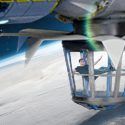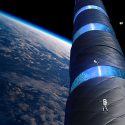We’ve talked about settling on the Moon, Mars and even Venus. But how about somewhere that’s cold, dark and smells like farts? Uranus. What would conditions be like on this ice giant? What kind of settlement would you need to build? And what dangers would you encounter on the stinkiest planet in the Solar System?
Welcome to your new home on the seventh planet from the Sun. You’d now be a whopping 2.9 billion km (1.8 billion mi) away from our Solar System’s energy source. Following in the footsteps of NASA’s Voyager 2 probe, the journey to Uranus would take about nine and a half years. But now that you’ve made it, you would catch a great view of this ice giant.
What you’d find is a planet four times wider than the Earth, orbited by 27 known moons and 13 rings. Plus, it would be rotating east to west. And tipped over on its side. Well, it’s about time you head down to the surface. Wait, where’s the surface? As you descend, hold your nose. This place stinks. The gassy atmosphere of Uranus is primarily made up of hydrogen, helium and methane.
The higher altitudes would be the smelliest, thanks to the pungent rotten egg smell of hydrogen sulfide. Going further down toward the planet’s surface, you’d start to notice there isn’t one. Uranus is smaller and compositionally different than the gas giants Jupiter and Saturn. It consists of slushy water, methane and ammonia fluids above a small rocky center.
Not that you’d be able to see very much. Uranus only receives about 0.27% as much sunlight as the Earth. So you’d be living in darkness. With the lack of sunlight and surface, you couldn’t grow your own food there. Your ship would need to supply you with food. But you could source your water from the planet’s water ice. You’d find conditions on the planet very cold and windy.
Temperatures in some parts of the atmosphere could be as low as -225 °C (-373 °F). That’s colder than Neptune, the outermost planet in the Solar System. Massive clouds of ammonia and methane ice crystals would swirl around you. Storms almost two-thirds the size of the U.S. would batter you with wind speeds up to 900 km/h (560 mph).
But it’s too late to turn back now. You’d need to figure out how to settle and survive in these conditions. Establishing yourself on the surface would be a definite no-go. And the strongest, most frigid winds would tear you apart in the lower altitudes. Your best bet would be a floating settlement up high in the clouds. But this wouldn’t be your average blimp or airship settlement.
Blimps only lift when inflated with a gas that is lighter than the surrounding atmosphere. On Earth, you’d use helium. On Uranus, there would be no lighter gas to use. That’s due to the atmosphere made of molecular hydrogen and atomic helium. However, you could try something more theoretical. Like a near-vacuum ship.
Instead of gas, this kind of ship would create a vacuum to lift. You’d simply remove gas or add it to allow the ship to go higher or lower. And it would be a clean technology. No fuel needed. You should get comfy because you’d never be able to leave your ship without your spacesuit. On Uranus, you couldn’t breathe. And you couldn’t survive a second in unbelievably frigid temperatures.
Stay safe and enjoy the view. Now that you’ve figured out how to survive, what would life on Uranus be like? For starters, you’d find a slightly different sense of gravity than you’re used to. But considering that Uranus is 15 times more massive than the Earth, you’d be surprised by the difference. Contrary to what you might think, you wouldn’t have to worry about being crushed.
The surface gravity would be only 90% as strong as the Earth’s. So if you weighed 75 kg (165 lb) on Earth, you’d now be a lighter 67 kg (148 lb). Another thing you’d have to get used to is time. One Uranian day would be equal to about 17 hours on Earth. That wouldn’t be so bad. But get ready for one incredibly long trip around the Sun.
One year on Uranus would equal 84 Earth years. You could die of old age before the year is over. You could even live an entire life in just one 42-year long summer or winter. A nice long summer on Earth sounds pretty good right about now. Maybe it’s time we tilted the Earth sideways on its axis to see what would happen.
Sources
- “Uranus”. 2022. nasa.gov.
- “NASA – How Far? How Faint? “. 2022. nasa.gov.
- “The Planet Uranus”. 2022. weather.gov.
- “What Is The Temperature Of Uranus?”. Daisy Dobrijevic, Nola Taylor Tillman. 2022. space.com.
- “The Largest And Deadliest Hurricanes To Hit The United States”. 2022. geology.com.



























